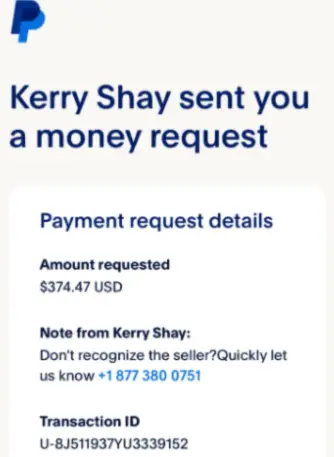The Kerry Shay Paypal Request Scam is an Email scam by scammers specifically targeting Paypal users. It actually started in 2021 but it has resurfaced again this year, 2024. These scammers are on the prowl and anyone that falls victim ends up losing money, personal data that could result in Identity theft.
What The Kerry Shay Paypal Money Request Scam Looks Like

The Kerry Shay Paypal Money Request Scam looks similar to a genuine Paypal request and if one is not careful you would actually think it is genuine. The scam invoice came to me via email and started with, ‘‘Hello allgroup9@Poragup.com’‘, and also urging me to call call a number if I don’t recognize the seller. ” The email also has a phone number listed and when I tried calling a man picked up and was asking some details like my Paypal log in details, etc. A clear Red Flag. Then I did a quick search on the name and found out it is a scam and there also were tons of complaints online about the name and also other people received same email, Another Red Flag.
How To Identify Phishing Scams Like The Kerry Shay Paypal Money Request Scam
Now here is how to identify Phishing attempts like the Kerry Shay Paypal Money Request Scam:
- Unexpected Invoices: If you receive an invoice for services you didn’t order, it’s a red flag.
- Generic Company Names: Scammers often use vague or generic company names and hen you see these it should raise Red Flags!
- Urgent Payment Requests: Scams often pressure you to pay quickly because they know if you waste time or seek another opinion you might find out it is a scam and not pay.
- Contact Information: Look for suspicious or inconsistent contact details, such as generic email addresses or phone numbers that don’t match the company’s official records.
- Invoice Details: Check the invoice for missing or incorrect details, such as wrong account numbers or unfamiliar services.
How To Avoid Scams Like The Kerry Shay Paypal Money Request Scam
- Verify Before Paying: Always verify the legitimacy of any invoice before making a payment. Contact the company directly using official contact information, not the details provided on the invoice.
- Keep Records: Maintain detailed records of all transactions and service agreements. This makes it easier to identify fraudulent invoices.
- Use Spam Filters: Set up spam filters to block suspicious faxes and emails.
- Report Scams: Report any fraudulent invoices to the appropriate authorities, such as the Federal Trade Commission (FTC) in the United States.
Avoiding phishing scams requires vigilance and awareness. Here are some effective ways to protect yourself from phishing attacks:
Tips to Avoid Phishing Scams:
- Be Skeptical of Unexpected Communications:
- Be cautious with unsolicited emails, texts, or calls, especially those asking for personal or financial information.
- Verify the Source:
- Always verify the sender’s email address or phone number. Scammers often use addresses or numbers that look similar to legitimate ones.
- Look for Red Flags:
- Check for spelling and grammatical errors, generic greetings (e.g., “Dear Customer”), and urgent or threatening language.
- Don’t Click on Suspicious Links:
- Hover over links to see the actual URL before clicking. If it looks suspicious or doesn’t match the purported sender, don’t click it.
- Check the Website’s Security:
- When entering personal information online, ensure the website is secure. Look for “https://” in the URL and a padlock icon in the browser’s address bar.
- Avoid Downloading Attachments:
- Don’t open email attachments from unknown or suspicious sources. These could contain malware.
- Use Multi-Factor Authentication (MFA):
- Enable factor Authentication on your accounts so as to add an extra layer of security. This makes it harder for scammers to gain access even if they have your password.
- Report Phishing Attempts:
- Report suspicious emails to your email provider and the organization being impersonated. In the U.S., you can forward phishing emails to the Anti-Phishing Working Group at reportphishing@apwg.org and to the FTC at spam@uce.gov.
What Do You Do When You Suspect A Phishing Attempt
In this digital age and time, almost everyone has at one time received a phishing text or email and often times they fall victim and get scammed. This is why it is imperative that you are always careful when you receive any text or email because one careless click on a link can cause a whole lot of problems for you. Now if you suspect a phishing attempt, here is what I advise you do:
- Do Not Respond to the text, because you responding is actually giving access to the scammers, simply delete it when you receive.
- Quickly change your password if you have mistakenly clicked on the link or given away your login details. Change your password to a strong and unique password.
- Keep an eye on your accounts for any unauthorized transactions.
- Also scan you devices for any malware.
By following these tips, you can significantly reduce your risk of falling victim to phishing scams and keep your personal and financial information safe.
Conclusion
This internet age came with so many advantages and also disadvantages. Phishing is an example of one of such. Internet users should always apply caution and be wary. Scammers often use scare tactics or urgency to manipulate individuals into taking quick actions. It’s essential to stay vigilant and take precautions to protect your personal information and finances from such scams.